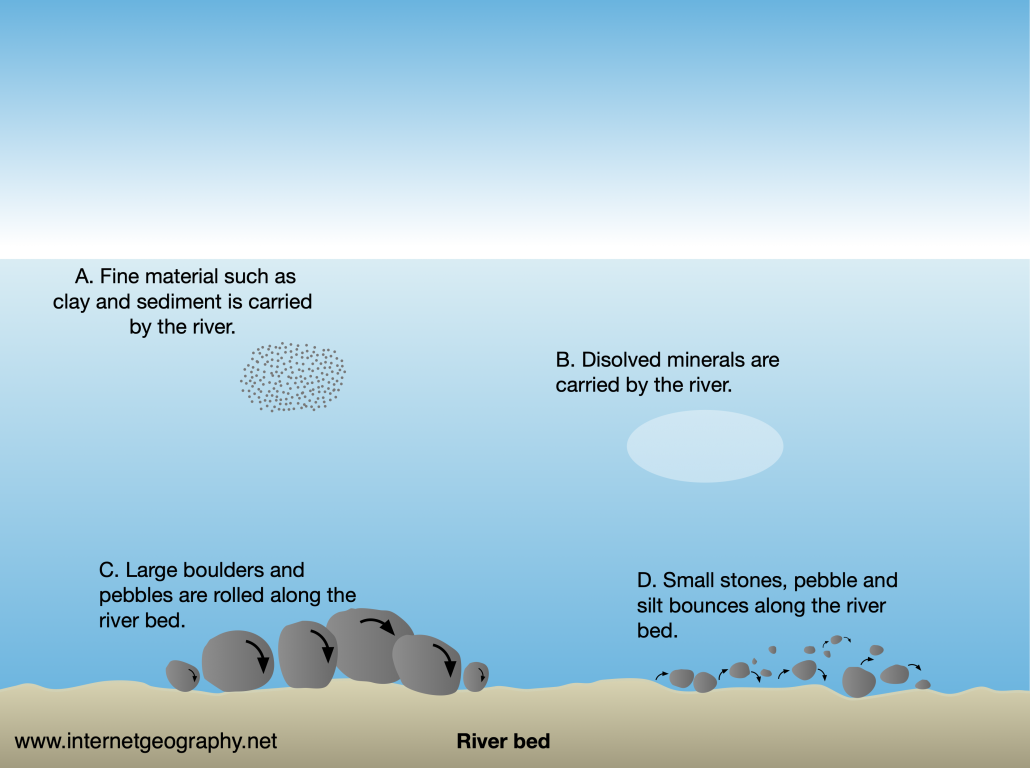River Processes
Processes of river erosion
- Hydraulic Action: This is the sheer force of the water hitting the river banks. Fast-flowing water exerts pressure on the bank’s sides and bed, leading to erosion. When water infiltrates cracks and then suddenly moves, it can dislodge chunks of the bank or bed.
- Abrasion (or Corrasion): When the river’s load (the sediment it carries) grinds along the bed and banks, acting like sandpaper and wearing them away. Rocks and pebbles carried by the river scrape and rub against the channel, eroding it.
- Attrition: Rocks and stones that the river carries knock against each other, breaking into smaller, rounder, and smoother fragments. It’s like a natural rock tumbler, where rough edges get smoothed over time.
- Solution (or Corrosion): This is a chemical process where certain rock types, like limestone or chalk, dissolve in the river’s water. Over time, this process can erode the river bed and banks.
Factors affecting river erosion include:
- Load: The heavier and more angular the material a river carries, the higher the chance of erosion.
- Velocity and Discharge: A faster flow and greater volume of water amplify the potential for erosion.
- Gradient: A steeper slope boosts the rate at which erosion occurs.
- Geology: Softer, loosely packed rocks, like sand and gravel, erode more readily.
- pH: The more acidic the water, the faster materials dissolve.
- Human Impact: Activities like deforestation and constructing dams and bridges disrupt the river’s natural course, often leading to heightened erosion.
Processes of river transportation
- Suspension: This is when fine, light particles like silt and clay are lifted by the river’s turbulent flow and carried within the water column. These particles remain ‘suspended’ in the water, making it cloudy or muddy.
- Saltation: This involves slightly heavier, coarser particles such as sand and gravel. They are too heavy to be continuously suspended but too light to remain on the riverbed. Instead, they ‘hop’ or ‘bounce’ along the river bed, lifted by the water’s flow and then settling back down.
- Solution: This is a chemical process where soluble materials, such as certain minerals or rocks (e.g., limestone), dissolve in the river water and are transported in solution form. This means the transported materials are not visible to the naked eye.
- Traction: Larger, heavier materials, like pebbles and boulders, are rolled along the riverbed. These materials move less frequently than those in suspension or saltation, typically only during high-flow conditions.
- Flotation: This isn’t a standard term in river transportation within iGCSE Geography. However, in general terms, flotation refers to materials (like leaves or twigs) that float on the water surface and are carried downstream.
Each of these processes can be active simultaneously in a river, with the dominant process often changing depending on factors like river velocity, volume, and the load available.
Processes of deposition
Deposition primarily occurs when the velocity of a river decreases, and it no longer has enough energy to transport its load. Factors leading to deposition include:
- Decreased Gradient: As the river moves from steeper to flatter terrains, it slows down, leading to deposition.
- Decreased Volume: When the river’s volume reduces, especially in drier seasons, it can’t carry as much sediment.
- Meeting an Obstacle: When a river encounters an obstacle like a dam or another body of water, its speed reduces, causing deposition.
- Increased Load: If a river picks up more material than it can carry, it’ll deposit the excess.
- Human Interference: Activities like dam construction can artificially slow down a river, inducing deposition.
Deposition can occur at various points along a river’s course:
- Inside of Meanders: The river flows slower on the inside bend of a meander, causing deposition.
- Floodplains: When a river floods, it spills over its banks and slows down, depositing material across the floodplain.
- Mouths and Deltas: As rivers meet larger bodies of water like seas or lakes, their speed decreases, forming deltas from deposition.
- Confluences: When two rivers meet, the combined water can slow down if the joining river has a lower velocity, leading to deposition.
Summary
Flashcards
Check Your Knowledge
Coming soon

